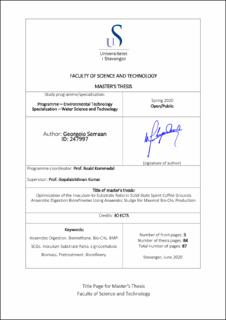| dc.contributor.advisor | Kumar, Gopalakrishnan | |
| dc.contributor.author | Semaan, Georgeio | |
| dc.date.accessioned | 2020-10-20T11:31:52Z | |
| dc.date.available | 2020-10-20T11:31:52Z | |
| dc.date.issued | 2020 | |
| dc.identifier.uri | https://hdl.handle.net/11250/2683881 | |
| dc.description | Master's thesis in Environmental Technology | en_US |
| dc.description.abstract | The optimization of bio-CH4 production from spent coffee grounds (SCGs) using anaerobic sludge (AS) under different inoculum-to-substrate ratios (ISRs) using solid-state batch-fed anaerobic digestion (AD) reactors was tested. All reactors were operated under mesophilic conditions (37 °C) and run at least in duplicates. The working volume was fixed at 400 ± 20 mL. The initial moisture content of the SCGs was measured at 58.4%. The tested ISRs were 0.5, 1, 2, 3, 4, 5, and 6 on a volatile solids (VS) basis (g VSAS /g VSSCGs). The biomethane potential (BMP) was determined after subtracting the blank AS BMP. Reactors with an ISR of 2 (8g VSAS 4g-1 VSSCGs) showed the highest cumulative BMP of 1401 ± 137 NmL CH4. However, reactors with an ISR of 6 (8g VSAS 1.33g-1 VSSCGs) exhibited the highest specific BMP of 533 ± 22 NmL CH4 g1 VSSCGs. The lowest was attributed to reactors with an ISR of 0.5 with a BMP of 271 ± 12 NmL CH4 g-1 VSSCGs, where after 41 days, anaerobic bioprocesses had not yet ceased. Placed in descending order of specific BMP, it follows ISR 6 > ISR 4 > ISR 3 > ISR 5 > ISR 2 > ISR 1 > ISR 0.5. Linear regression showed a clear trend between the achievable BMP and the ISR used. No pretreatments were applied to enhance biomethanation. Microbial growth was modelled using the modified Gompertz equation and showed a near perfect fit to the model (R2 = 0.98 to 0.99). The hydrolysis constant (kh) at ISR 0.5 was revealed to be as low as 0.02 days-1, and assumed to be inhibited by high VFA concentrations, especially propionic acid. The VS reduction was 76.2 ± 12.6% in ISR 0.5 reactors. The COD removal efficiency was 61.6 ± 3.2% in ISR 1 reactors. A total of 5881 kgs of SCG were produced in 2018 at the University of Stavanger (UiS). This can yield an average of 39088 MJ of heat and 369 kWe of power yearly. This enables SCGs bioprocessing in sustainable AD biorefineries whilst maintaining the integrity of their circular bioeconomy. | en_US |
| dc.language.iso | eng | en_US |
| dc.publisher | University of Stavanger, Norway | en_US |
| dc.relation.ispartofseries | Masteroppgave/UIS-TN-IKBM/2020; | |
| dc.subject | Bio-CH4. | en_US |
| dc.subject | anaerobic digestion | en_US |
| dc.subject | biomethane | en_US |
| dc.subject | spent coffee grounds | en_US |
| dc.subject | inoculum substrate ratio | en_US |
| dc.subject | lignocellulosic biomass | en_US |
| dc.subject | pretreatment | en_US |
| dc.subject | biorefinery | en_US |
| dc.subject | teknisk miljøvern | en_US |
| dc.subject | vann | en_US |
| dc.subject | water science | en_US |
| dc.subject | BMP | en_US |
| dc.title | Optimization of the Inoculum-to-Substrate Ratio in Solid-State Spent Coffee Grounds Anaerobic Digestion Biorefineries Using Anaerobic Sludge for Maximal Bio-CH4 Production. | en_US |
| dc.type | Master thesis | en_US |
| dc.subject.nsi | VDP::Teknologi: 500::Miljøteknologi: 610 | en_US |
